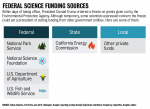UCLA environmental researchers are anxious about the future of federal funding for their research after President Donald Trump temporarily froze grants from a federal agency.
The Trump administration lifted the executive order that temporarily suspended all funds from the Environmental Protection Agency on Friday, but environmental scientists still have concerns about the future of their research.
“Depending on the type of research being done, a freeze on payments may have impacts that can’t be reversed,” said Felicia Federico, executive director of the California Center for Sustainable Communities. “For example, if a scientist has to cancel planned field work or travel, they may be working with windows of opportunity that close and cannot be rescheduled.”
The California Center for Sustainable Communities is a center housed at UCLA that works to improve urban system sustainability.
Federico said she received a grant from the EPA for the EPA Urban Waters Civic Action Project, which works to engage underserved high schools in addressing water-quality issues and provide students with science and civic educations.
Federico said she was horrified when she heard about Trump’s executive order. She added that when Trump issued the order, other researchers were also worried about whether their grants would be taken away.
Erik Porse, associate research director at the California Center for Sustainable Communities, said he thinks it is not unusual for a new presidential administration to place a freeze on funds. However, he said he thinks the difference in size of the freeze is important.
“It was more a larger-scale action (than in previous administrations) to get a handle on the activities that are currently taking place,” Porse said.
Jeff Holmquist, a researcher at the White Mountain Research Center, said he does not receive funding from the EPA, but has seen the reactions of his colleagues who do receive funding from the agency.
The White Mountain Research Center is a unit of UCLA’s Institute of the Environment and Sustainability that works to support college-level research and instruction.
He added he thinks the situation is better since the freeze has been lifted and there are no major restrictions on funding as of now.
Trump’s executive order banned external communication among researchers during the freeze, including the Agriculture and Interior departments.
When the freeze was announced, Holmquist checked with his colleagues in the Interior and Agriculture departments about whether he would be able to exchange research information with them, even though the order did not apply to him. He said at least for now, there are no major restrictions in place.
Even without the EPA freeze, researchers said they find it difficult to secure funding – either from the government or private sources.
“Federal funding around environment and climate issues may not be as favorable in the current administration,” Porse said, “But in general it is more difficult in recent years in the lines of funding (because) funding is more competitive today.”
Federico said the common sentiment is that it has recently been more challenging to secure funding from the National Science Foundation, a major source of funding for environmental scientists. She added she does not know if the challenge can be attributed to competition in applicants or a cut in funds from the foundation.
However, federal funding sources are not the only source of money for environmental researchers. For example, local governments such as Los Angeles County, state agencies such as the California Energy Commission and private foundations also provide funding.
Porse said he thinks the general picture for environmental and climate funding is more challenging than before, and researchers need to be creative and find opportunities.
“All (funding for) research is very competitive no matter what,” Porse said.

No good.